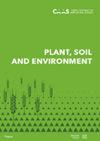Impact of Erythroxylum coca cultivation on soil quality in the Aguaytia valley, Peru
IF 1.8
3区 农林科学
Q1 AGRONOMY
引用次数: 0
Abstract
In Peru and other countries, E. coca leaf is cultivated for its transformation into cocaine; this process includes the use of insecticides, herbicides and monoculture systems, which generate negative effects on the soil and environmental damage little treated by researchers. The research evaluated the potential effects, through modeling, of E. coca cultivation on physicochemical indicators and soil quality indices (SQI) in the Aguaytia valley, Padre Abad province, Ucayali region, Peru. Areas with E. coca cultivation of 2 (CO2) and 15 years (CO15), ex-coca with natural regeneration of 9 years (EC9), and secondary forest (BS) were evaluated as reference; evaluating soil physical and chemical indicators. The results show differences in all the soil indicators evaluated, except K+. The principal component analysis determined that the indicators clay, sand, silt, MO, N, Ca2+ and SAl were relevant and explained 82.97% of the total variance. In addition, the modeling shows that 15-year-old E. coca has a negative impact on sand, clay and Ca2+, and a positive impact on silt and SAl, but no statistically significant impact on OM and N. The soils presented low quality for BS and very low quality for CO15. In conclusion, the modeling and the ICS show that the cultivation of Erythroxylum coca under monoculture has a significant negative impact on Ca2+ and positive impact on Al3+, %AC, %SAl, % of silt, which caused a loss in soil quality, in addition, recovery is observed in the area of excoca with 09 years of natural regeneration.古柯红栽培对秘鲁Aguaytia河谷土壤质量的影响
在秘鲁和其他国家,种植古柯叶是为了将其转化为可卡因;这一过程包括使用杀虫剂、除草剂和单一栽培系统,这些对土壤和环境造成负面影响,研究人员很少处理。本研究通过建立模型,评价了古柯种植对秘鲁乌卡亚利地区帕德雷阿巴德省Aguaytia山谷的理化指标和土壤质量指标(SQI)的潜在影响。以古柯栽培年限为2年(CO2)和15年(CO15)、自然再生年限为9年(EC9)、次生林(BS)为参考;评价土壤理化指标。结果表明,除K+外,所有土壤指标均存在差异。主成分分析表明,粘土、砂土、粉土、MO、N、Ca2+、SAl等指标具有相关性,对总方差的贡献率为82.97%。此外,模型还显示,15年古柯对沙、粘土和Ca2+有负影响,对粉砂和SAl有正影响,但对OM和n没有统计学意义上的显著影响。土壤的BS质量较低,CO15质量很低。综上所述,模型和ICS表明,单作栽培古柯红对Ca2+有显著的负影响,对Al3+、%AC、%SAl、%粉土有显著的正影响,造成土壤质量损失,并在09年自然更新期的古柯红区出现恢复。
本文章由计算机程序翻译,如有差异,请以英文原文为准。
求助全文
约1分钟内获得全文
求助全文
来源期刊

Plant, Soil and Environment
Agronomy, Soil Science-农艺学
CiteScore
4.80
自引率
4.20%
发文量
61
审稿时长
2.4 months
期刊介绍:
Experimental biology, agronomy, natural resources, and the environment; plant development, growth and productivity, breeding and seed production, growing of crops and their quality, soil care, conservation and productivity; agriculture and environment interactions from the perspective of sustainable development. Articles are published in English.
 求助内容:
求助内容: 应助结果提醒方式:
应助结果提醒方式:


